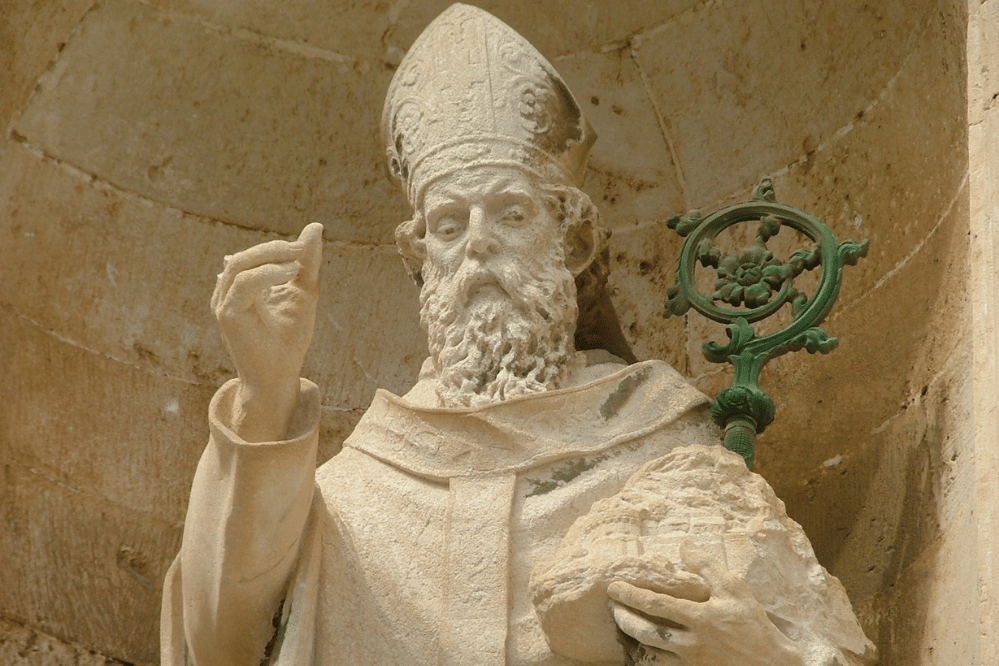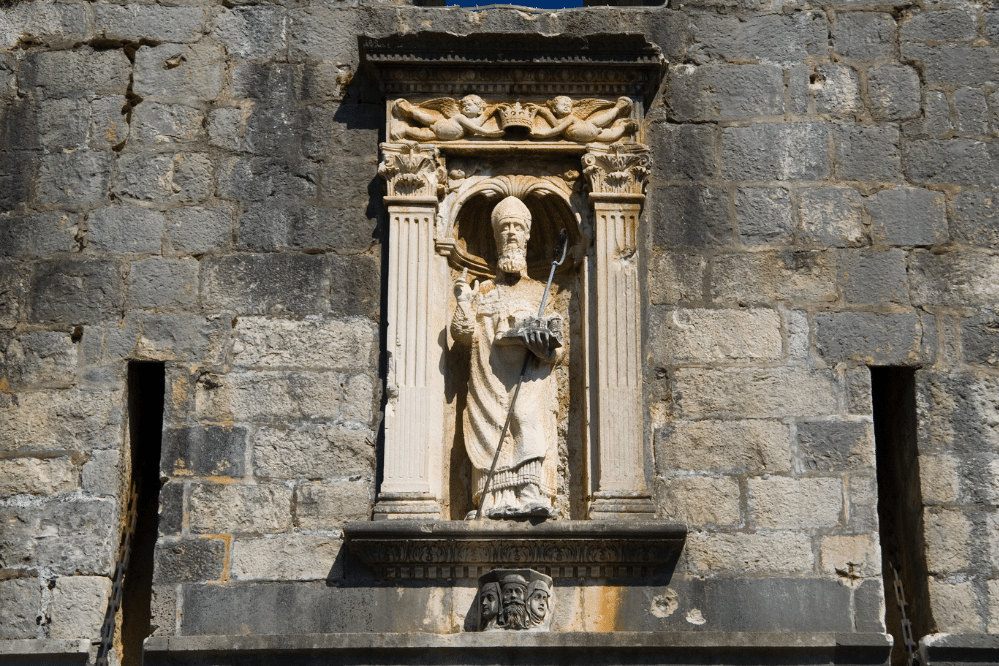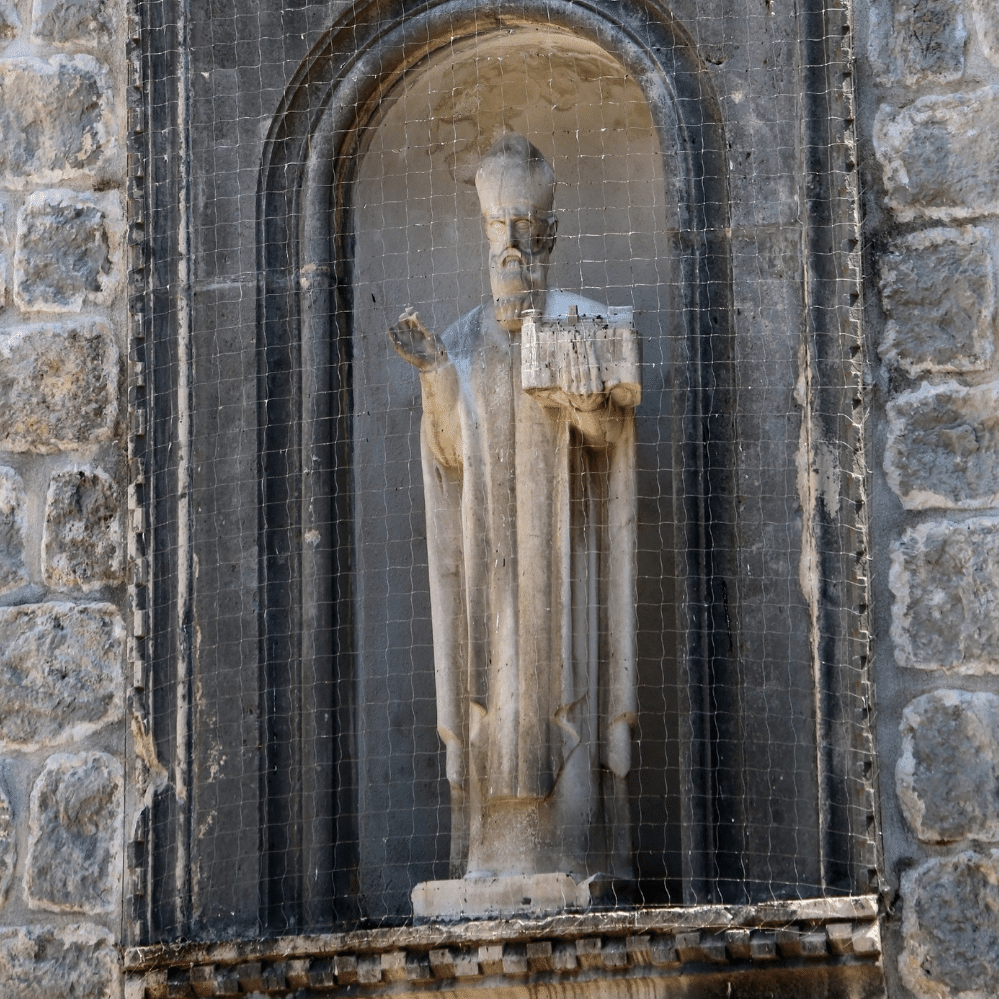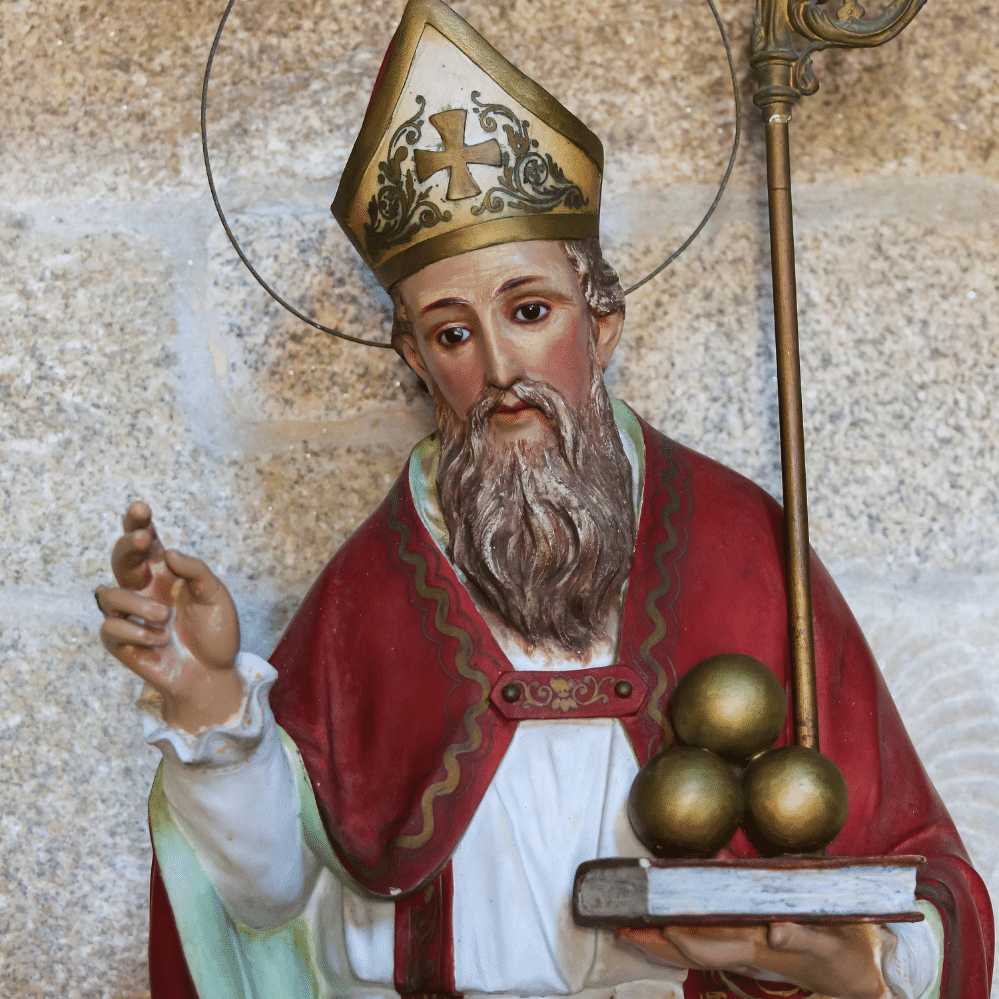Table of contents
Who is São Brás?

St. Brás was born in Armenia in the middle of the third century. During his lifetime he was a great doctor, but at one point he went through a personal crisis because, no matter how excellent a professional he was, nothing was able to fill the space of God in his life.
Thus, he felt the need to seek God, and began to be evangelized. In this way, his life went through certain changes, and certainly, they were for the better. Many people began to be evangelized through his teachings. And so, he even became bishop, by the will of the people who acclaimed him.
The story of St. Brás reserves numerous brilliant and faith-filled details. Successor to the apostles, Brás was always a very brave man. If you were interested in the story.
History of São Brás

To truly understand the history of a saint, it is fundamental that you know his origin, passing through all the stages of his life.
By having access to all this information, you can truly understand the construction of the history of the saint, and know the reason for his sanctification. Follow below for all these details.
Born in Sebaste, Armenia
Known today mainly for being the protector of the throat, Saint Brás was born in a town called Sebaste, in Armenia, around the year 300. Coming from a noble family, Brás received a Christian education from a very young age, and while still a young man he consecrated himself bishop.
Because he was a Christian, he suffered many persecutions from an early age. At one point he even had to retire to the mountains. In those regions lived many wild animals, however, this was never a problem for St. Brás, who always managed to tame them with great affection, to the amazement of many.
Always much loved by the faithful, during his sheltered period, he always received many visits in the cave. It was there that Brás became known as a saint, which soon spread, and from then on he began to collect stories and moments.
From doctor to hermit
The story of St. Brás as a hermit began when he began to question his profession as a doctor. He was an excellent professional, but this alone did not fill the emptiness he felt at not serving God the way he wanted.
At this point, he decided to live in constant prayer, thus becoming a hermit. Because of this decision, Bras started living in a cave, where he stayed for many years. There, he helped many people, and this made the fame of a miracle worker spread. But these details you will see below.
Fame of miraculous cure
During the time he lived in the cave, Brás helped everyone who looked for him, and so there were many reports at the time that he was able to heal both physical illnesses and illnesses of the soul.
Thus, his fame soon began to spread throughout the region of Cappadocia. The sanctity of Brás was already so visible, that even the wild animals lived in total harmony with him, without ever having been attacked, or suffered any kind of problem with the animals.
Becomes Bishop
As soon as the bishop of the town in which he lived died, almost the entire population that acclaimed Brás went to him with a noble request. The desire of the people was that Brás would accept to be the new bishop, and take care of them all.
Believing it to be his mission, Brás accepted, and so he had to leave the cave to live in the city. There he was ordained a priest, and then, some time later, he was consecrated bishop. After this achievement, Brás built a house to house the diocese. The construction was done at the foot of the cave he had lived in in the mountains, and from there he could command the entire church.
The pursuit of Agrícola
The mayor of the city where Bras lived, Sebaste, was a true tyrant who fought Christianity with blood in his eyes throughout the region of Cappadocia. With this information, one can already imagine that he was not at all pleased to learn that there was a man in the region with a reputation as a saint.
His name was Agrícola, and to make matters worse, he was a friend of the Emperor of the East, called Licinius Lacinianus, brother-in-law of Constantine, Emperor of the West, who chose to stop persecuting Christians. Thus, for Licinius, continuing the persecution of religious people was an affront and a kind of dispute with his brother-in-law.
One certain day, Agrícola ordered his soldiers to go to a place near the cave where Bras was staying, to get some wild animals like lions, for example, so that they could serve as a cruel spectacle during the martyrdom that was done to the Christian prisoners.
However, when they arrived at the place, the soldiers observed that all the wild animals lived in perfect peace with Brás, which shocked them. Thus, they wasted no time and immediately ran to the mayor to tell him their discovery. This eventually resulted in the arrest of Brás, and these details you can check below.
São Brás Prison
Upon discovering that Bras lived in perfect harmony with wild animals in his cave, Agrícola was furious, and ordered the saint to be arrested. Bras, in turn, did not offer any resistance to the soldiers.
When he came in front of the mayor, the same ordered that St. Brás renounced Jesus Christ, and also the whole Catholic Church. In addition, Agrícola ordered Brás to start worshipping his gods.
However, St. Brás stood firm, and said in no uncertain terms that he would never renounce either God or Jesus Christ. The saint also made a point of affirming that the Catholic Church would never end, because it was guided by the power of the Holy Spirit.
The mayor tried to make Brás change his mind countless times, however, intact, the saint kept his posture. All this, increased even more the wrath of Agrícola, who in turn, maintained the order of arrest against the saint.
During all the time he was in prison, countless faithful continued to visit São Brás in prison, in order to ask for prayers and blessings. Although the saint went through very difficult times in prison, and suffered a lot of torture, he never stopped attending to any of the faithful.
The miracle of the throat
Nowadays, Saint Bras is known mainly for being the protector of the throat. What many people don't know is the story that made him gain this fame. One day, a mother was in total despair, because her son was choking with a thorn in his throat, and for this reason was almost coming to death.
The mother then, in desperation, looked for St. Brás. Upon separating from the situation, St. Brás looked up to heaven, said a prayer, and then made the sign of the cross on the boy's throat, which was miraculously healed. Because of this, to this day the saint receives many requests for intercession when the subject is throat problems.
The death of Saint Bras
During the time he was in prison, many of the faithful went there, both to ask for help and to help with the injuries he was suffering. However, one day, some of these women were found by the soldiers, who killed them by throwing them into the lake.
Then they did the same with Brás, but, to the surprise of many, he walked on water and nothing happened. This episode infuriated Agrícola even more, who ordered that they beheaded St. Brás. Thus, he died having his throat cut, on February 3, 316.
The image of São Brás

The image of São Brás brings with it many special elements that have a great meaning, from its miter, through the green tunic, to the candles of the saint, which form a cross.
Know that everything that makes up the image of São Brás, has a reason, and nothing is there at random. Understand these details in sequence.
The mitre of São Brás
Each component present in the image of St. Thomas tells important details of the life of this saint. His miter, for example, is a great symbol of his episcopal mission. It is worth remembering that at one point in his life, Thomas was bishop of the Church of Sebaste, in a period when persecutions against Christians were frequent and severe.
Thus, even with all these difficulties, St. Brás showed himself to be a great spiritual leader, besides being an example pastor to his faithful. In these functions, Brás always helped and healed the afflicted who sought him, both in the health of the body and of the soul.
The red chasuble of Saint Bras
The image of Saint Brás brings a representation of him as a bishop, in which among his vestments, one can find a red chasuble. This color is a representation of the blood of the martyrs, and of course, also of the martyrdom of Saint Brás himself. It is worth remembering, after all, that because he was a Christian, Saint Brás was imprisoned in Armenia, where he was tortured and finally killed.
After all, for not renouncing Jesus Christ, St. Brás was brutally killed in a decapitated manner.
The green tunic of Saint Bras
In the vestments of St. Brás we can also see his green tunic, which is a representation of the liturgical tunic of ordinary time. It also has another very strong meaning, representing the life that conquers death in Christ. After all, St. Brás died a brutal death, but ascended into heaven to live eternal life.
Thus, by preferring to die rather than deny Jesus Christ, St. Brás won the crown of victory in heaven. He overcame the brutal death he suffered, and still made sure that his story and miracles were marked in everyone's memory for centuries and centuries.
The right hand of St. Brás blessing
In representations of his image, Saint Brás always appears blessing with his right hand. This is a way of recalling the gesture he often made when praying for the sick.
It is worth remembering, that through the intercession of his prayers, many sick people have been cured of illnesses both physical and of the soul.
The candles of São Brás forming a cross
In his left hand, Saint Brás holds two candles in the shape of a cross, which symbolizes the blessing of Brás, still when he was bishop. Besides, this representation has the purpose of remembering the episode in which Saint Brás saved a child who was choking to death with a fish bone in his throat.
After this event, he came to be considered the protector of the throat. Thus, on the day of his commemoration, always on February 3, priests usually make the blessing of the throat, using two candles in the shape of a cross to bless this region of the body.
Miracles of São Brás

Like any good saint, it is clear that St. Brás cultivated many miracles throughout his life, so there are many of his stories that are known among the faithful around the world.
From the baby saved from death, to the salesman who was converted through Saint Bras, here are some of the miracles of Bras.
Baby saved from death
In the year 1953, a child who was about 5 years old, and was the son of a Pastor named Joseph, contracted a serious throat disease. The disease worsened as the days went by, until at one point the doctor came to tell the parents that there was nothing more that could be done to save him.
In desperation, the child's parents asked the parish priest, Don Ernesto Valiani, to allow the relics of Saint Brás to remain in the family home overnight, in the hope of obtaining a grace through the saint. The priest allowed this to be done, however, the next day the child was still in the same condition.
The relics had to be taken back to the church because they were to be used during a procession. As soon as the procession passed near the place where the family lived, the distressed father reinforced his request for the cure of his son. Soon after the procession, when the priest went to visit the sick, he noticed that the child had improved, thus escaping death.
The bonfire of São Brás
There was a time many, many years ago, that it was customary to make a bonfire on the eve of São Brás Day, to honor him. So, a believer went to a farm, and got a good amount of wood, taking it to the place where the bonfire would be made.
However, when he realized this, the farmer was very angry and went after him. When he got there, even though his wife was against his decision, the landowner, with the intervention of the police, was able to recover his wood.
In the middle of the road, when passing by a church in São Brás, his horse came to a standstill and would not walk at all, so the farmer had to remove some of the wood from the cart so that it could continue its journey. He assumed that all that wood was too much for him.
After this episode, convinced by some young people of the region, the farmer donated all the wood to be burned in honor of the saint. After that, in a miraculous way, the horse walked again. From that, the farmer started to donate every year, the wood for the feast of São Brás.
The repentant salesman
A certain peanut vendor had his stall near a church in Santa Sofia, where the procession of São Brás usually takes place. So, one fine day, this same vendor was amazed to see the number of people who were arriving for the procession.
When he saw that the image of São Brás was small, as it was only a bust, the vendor spoke the following words with disdain. Such a big party for such a half bust. The procession continued, and the vendor returned to his house.
However, as he entered his home, he felt a great tightness in his throat, as if something was taking his breath away. Nervous, the man began to scream, and it was at that moment that he heard a voice that said, I am that half bust you saw in Corsano.
At that moment, the man understood that what he had said earlier had been words full of blasphemy. He then asked forgiveness, and promised his eternal devotion to St. Brás. Soon afterwards he was healed.
To connect with São Brás

Throughout this article, you have been able to know all the details of the history of St. Brás. So, if you feel affinity with this saint, and want to connect with him, it is essential that you know his prayer, novena and of course, his famous blessing.
You can find out all this information below, so please read on.
Saint Bras Day
St. Brás was beheaded to death on February 3, 316, thus always on this date the saint's day is celebrated. As he is the protector of the throat, every February 3, in churches around the world, there are usually masses dedicated to him with the famous blessing of the throat, which is done by priests with two candles in the shape of a cross.
Prayer to Saint Bras
"O glorious Saint Brás, who by a short prayer restored perfect health to a boy who, by a fishbone pierced through his throat, was about to expire, obtain for us all the grace to experience the efficacy of your patronage in all ills of the throat.
Keep our throats sound and perfect so that we may speak properly and so proclaim and sing the praises of God. Amen."
Blessing of Saint Brás
"Through the intercession of St. Thomas, Bishop and Martyr, deliver God from the evil of the throat and from every other disease. In the name of the Father, the Son and the Holy Spirit. St. Thomas, pray for us. Amen."
Novena of St. Brás
O blessed Saint Brás, who received from God the power to protect men against diseases of the throat and other ills, remove from me the disease that afflicts me.
(Make your request)
Preserve my throat sound and perfect so that I may speak correctly and thus proclaim and sing the praises of God. With God's grace and with Your help, I promise to strive, O glorious Martyr Saint Brás, that the speech that comes out of my throat may always be:
Of truth and not of lies; Of justice and not of slander; Of kindness and not of harshness; Of understanding and not of intransigence; Of forgiveness and not of condemnation; Of apology and not of accusation; Of respect and not of contempt; Of conciliation and not of intrigue; Of calm and not of irritation; Of detachment and not of selfishness; Of edification and not of scandal;
Of cheerfulness and not of defeatism; Of conformity and not of whining; Of love and not of hate; Of joy and not of sadness; Of faith and not of unbelief; Of hope and not of despair.
St. Brás intercede before God for me, for my family and for all who suffer from throat ailments. By our words may we bless God and sing his praises.
Saint Brás, pray for us! (3 x)
O God, through the intercession of St. Thomas bishop and martyr, deliver us from the ills of the throat and from all sickness and every disease. Amen.
What is the main cause of St Bras?

St. Thomas is considered the patron saint of veterinarians, animals, masons, sculptors, construction workers, and protector of the throat. However, for sure, it can be said that the reason he became most known was the one cited last.
After an episode in which he saved a child who was dying with a thorn choked in the throat, the fame of São Brás for the protection of this region of the body, soon spread, and lasts until the present day. That is why it is very common among the devotees, whenever someone chokes, to say out loud: "São Brás, São Brás".
Thus, the faithful around the world have recourse to this saint when it comes to throat ailments. Regardless of the disease, Saint Brás is an intercessor in these causes, and if you truly trust in him, know that you can always count on his compassion.

